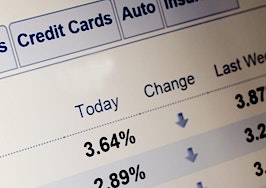- The Urban Land Institute released its semi-annual Real Estate Consensus Forecast, a compilation of data based on a survey of 48 analysts and economists from 36 real estate organizations.
- The resulting report takes the median of the collected forecasts and makes projections in a number of economic and real estate industry areas, including GDP growth, vacancy rates, investment returns and home prices.
- Toward the latter portion of the nation's economic recovery, we're apt to see continuing but diminished growth to pave the way for an imperfect, stabilizing market.
Yesterday the Urban Land Institute released its ninth semi-annual Real Estate Consensus Forecast, a compilation of data based on a survey of 48 analysts and economists from 36 real estate organizations.
The resulting three-year projections (2016 through 2018) in the areas of GDP growth, vacancy rates, housing starts and prices are compared to past years’ numbers up to 2004 as well as a 20-year baseline average. The reported numbers are the median of the collected forecasts.
Although much of the forecast emphasized commercial space, here the focus will be on what was said about residential real estate and broad economic indicators.
Economic state and predictions
Overall, the economy is expected to continue expanding, but analysts are projecting a slower growth pace than we’ve experienced over the past two years. As the chart shows, real GDP growth has hovered at or below the 20-year average line (in blue) since 2010 when it climbed out of the negative.
[Tweet “The economy is predicted to continue expanding, but at a slower rate.”]
Continuously falling below the long-term average, GDP growth is predicted to decline slightly from 2015 to 2016 and marginally fluctuate into 2018.

Urban Land Institute, ULI Center for Capital Markets and Real Estate
We’ve seen a steady decline in the country’s unemployment rate during the economic recovery period, and that trend is projected to continue in immediate years at a slower pace, staying at or slightly below the 5 percent mark.
Compared to historical standards, and the nearly 10 percent unemployment rate recorded in 2009, the predicted unemployment rates for the next three years remain relatively low.
[Tweet “The predicted unemployment rates for the next three years remain relatively low.”]
Employment growth, which also bottomed out in 2009 with 5 million jobs lost, is expected to remain above the 20-year average but decline between 2015 and 2016 by about 11 percent to 2.5 million jobs gained. That number is expected to continue downward, with a predicted 1.5 million jobs gained in 2018 (the lowest annual growth in eight years).

Urban Land Institute, ULI Center for Capital Markets and Real Estate
The forecast also predicts that the four-year decline in inflation will reverse in 2016, rising to 1.5 percent and then remaining comfortably at a healthy 2.0 percent — just slightly below the 20-year 2.2 percent average.
Ten-year treasury rates are expected to rise to some degree without surpassing the 20-year average of 4 percent.
Real estate trends
With the exception of single-family housing starts and other factors more specific to commercial real estate, most indicators specific to residential are predicted to be better than their 20-year averages in 2016.
Home prices
Expectations for existing-home prices are more optimistic now than they were during the Urban Land Institute’s forecast six months ago. In 2015, home prices grew on average by 5.7 percent, according to the Federal Housing Finance Agency. The following years are predicted as follows:
- 2016: 5.0-percent increase
- 2017: 4.3-percent increase
- 2018: 3.9-percent increase

Urban Land Institute, ULI Center for Capital Markets and Real Estate
Capitalization (cap) rate (net operating income/sales price)
Since 2010, the cap rate has been decreasing and is predicted to hold steady at 5.1 percent in 2016, then rise to 5.5 percent by 2018 due to increased borrowing costs.
Apartment vacancy rates
Over the past few years, the apartment sector has fared well with regard to vacancy rates, experiencing a significant decline in vacant units from 7.1 percent in 2009 to 4.7 percent in 2015.
The forecast predicts apartment vacancy rates to rise on a small scale from 2016 to 2018, when it’s expected to reach 5.4 percent, a rate still stronger than the 20-year average.

Urban Land Institute, ULI Center for Capital Markets and Real Estate
Single-family housing starts
Formation of single-family housing is expected to increase from around 715,000 to 800,000 units in 2016, a trend that will continue with 850,000 and 900,000 new units expected in 2017 and 2018, respectively.
[Tweet “Formation of single-family housing is expected to increase but remain below the long-term ave.”]
NCREIF apartment annual returns
The National Council of Real Estate Investment Fiduciaries (NCREIF) total returns for all sectors (including industrial, office, retail and apartment) are predicted to fall below the long-term average.

Urban Land Institute, ULI Center for Capital Markets and Real Estate
Apartment returns, specifically, are forecasted to decline from 12 percent in 2015 to 8.6 percent in 2016, then hold steady at 7 percent in 2017 and 2018.
“I think the declining returns are what we would all expect,” said Jeffrey Havsy, chief economist, Americas Research and managing director, Econometric Advisors, during the results discussion. “We’ve had a really strong run — you combine that in with the slowing economy, even though there’s no recession, I think the fact that returns are coming down would be expected — I actually thought they might come down a little more.”
Martha Peyton, managing director, head of global real estate research at TIAA, also served as one of the four expert panelists and expressed her industry outlook.
“I agree that I think it’s very predictable that forecasters are seeing some mean reversion in returns,” she said. “After all, we’ve had six years of double-digit total returns, so the market’s been very good to investors.”
“But also, what I think strikes me and I see as totally predicable is the holistic story is very much of a Goldilocks story. It’s showing a tremendous amount of confidence that the Federal Reserve is going to get it right. That interest rates are going to be normalized, that inflation is going back to 2 percent. That the process is going to be gentle and successful and nurture a continuing well-balanced environment.”
Apartment rental rate growth
Apartment rental rates, which hit a near 10-year high in 2014 at 5.3 percent, are expected to downwardly progress as they did in 2015 to 4.3 percent, hitting 3.6 percent in 2016, an even 3.0 percent in 2017 and finally 2.4 percent in 2018.

Urban Land Institute, ULI Center for Capital Markets and Real Estate
Expert commentary
The report was released during a webcast yesterday afternoon, during which the majority of people listening (a little more than 65 percent) weighing in on the data’s validity thought it sounded “just right.” About 26 percent of people voted that the forecast was “too optimistic” with under 10 percent indicating it was “not optimistic enough.”
In terms of game-changers in the next six months, Mary Ludgin, managing director, head of global research at Heitman, talked about the potential for economic growth. “We’re adding jobs at a pretty healthy clip,” she said. To paraphrase, what if consumers start tapping into their oil price dividends and people formerly living with their parents finally move out?
Peyton summarized her industry outlook to wrap up the conversation:
“Overall, as a real estate researcher, I’m optimistic because our sector is very balanced,” she said. “Construction is relatively disciplined, so even if something — some kind of black swan event — creates a U.S. recession, I think that our sector would tolerate it relatively well. More like 2001 than 2008.”





